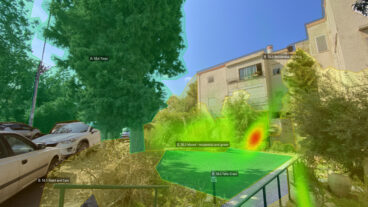Joseph Cory’s helium balloons made from fabric coated with photovoltaic (PV) solar cells. These balloons are much cheaper to build and install than existing solar panels, and also take up far less room, which is significant in an urban environment.
You can tell Joseph Cory is a dreamer. Turn to his company’s web site, Geotectura.com, and you see a host of ideas ranging from the wild – a one-meter square movable ‘house’ for the homeless, to the wacky, electro-magnetic skyscrapers that float above the ground. But out of this riotous imagination, Cory, a new breed of environmental architect, has developed a number of award-winning schemes that could help deal with some of the world’s most pressing problems – lack of renewable energy, and water scarcity.
The Israeli scientist, who is shortly to complete his PhD at the Department of Aeronautical Engineering, Architecture and City Construction, at Haifa’s Technion Israel Institute of Technology, has developed a new way to produce electricity using helium balloons made from fabric coated with photovoltaic (PV) solar cells. These balloons are much cheaper to build and install than existing solar panels, and also take up far less room, which is significant in an urban environment.
The balloons, which are a little like mini-Zeppelins, are connected to the ground via two cables: one to refill helium, and the other to pass the electricity to a control panel. The balloons can be connected to one another vertically, one meter apart, going up hundreds of meters into the sky.
“If you want more electricity you just have to add another balloon,” Cory tells ISRAEL21c. “The vertical dimension is unlimited as long as you are not based near an airport.”
Cory and his research partner at the Technion, Dr. Pini Gurfil, estimate that most homes would need just one or two balloons to supply their entire electrical needs. Apartment buildings or office blocks could use hundreds of balloons connected to the roof to supply part of their power needs, reducing costs substantially.
“The balloons don’t have to compete with regular energy sources. They can be used alongside it, saving energy and reducing costs by half,” explains 36-year-old Cory. “This invention is not trying to save the world or to say that what we have been using up to now is no longer important, it’s another option that can help to save money and indirectly also save the planet a little bit by not using polluting fuels.”
He envisages, for example, thousands of these balloons being installed in open urban areas like Central Park in New York. Visitors to the park would not be affected by the balloons, which would float in the sky high above the park, but the city authorities could use the electricity generated by them to power city amenities – like street lights for example.
Out of the city, the balloons could be used to generate electricity in remote places that are off the electricity grids. In the jungle, they could be floated high above the tree line, or at sea, ships could use them to power on-board facilities.
Cory imagines huge fields of balloons being set up to generate large quantities of electrical power. “Imagine seeing a field of those solar balloons, moving like grass in the wind,” says Cory. “It would be a much more beautiful and architectural sight than today’s ugly power stations.”
Gurfil, who is an expert in satellites, is working hard to ensure that the balloons are wind resistant. Already there are two working prototypes in operation in Haifa and in Israel’s desert, and work is continuing to find the optimal material and size. Installation will be simple. The idea is that the user can simply purchase a balloon from a shop or the Internet and install it themselves, without the need to bring in an expert.
Cory and Gurfil began working on the solar balloons, which have already been patented, about six months ago because they realized that one of the problems with solar energy today is that it is still not economic to use, both in terms of cost and space. In Israel most households have a solar panel on the roof that heats the water, but very few have solar panels to create electricity, even though the country has more than its fair share of sunny days.
“Today there’s so much focus on clean energy and we are being urged to use it as much as possible but people still prefer old fashioned electricity,” says Cory. “To generate electricity, solar panels have to be much larger and we simply don’t have the room for them. In order to make a huge amount of energy, you need a huge amount of space. When officials suggest creating solar energy plants in the Arava or Negev deserts, greens complain that the plants will destroy the environment.
“The balloons don’t have any negative effects on the environment at all. We are creating more space for the PV cells without taking away any urban space or landscape,” says Cory.
The researchers, who up to now have worked on this project in their free time, are now looking for funding of up to $2 million to build a prototype of their work and to begin the process of commercialization.
Aside from the solar balloon scheme, Cory and fellow architect, Eyal Malka of Malka Architects have also developed WatAir, an inexpensive solution that can bring clean drinking water to people in remote or polluted areas. Cory and Malka began work on the project to enter a competition sponsored by WaterAid, an international non-profit organization dedicated to providing safe domestic water to developing nations, and Arup, a British engineering company that specializes in sustainable designs. The two researchers went on to win first prize in the contest.
WatAir is an inverted pyramid with panels of three meters in height made from a variety of materials including elastic canvas, recycled polycarbonate, metal or glass, that can create dozens of liters of fresh water every day from the air. The design is low-tech, low-cost and can be produced from local materials, says Cory.
Cory and Malka came up with the idea of the pyramid after seeing how dew collects on tents and sleeping bags in the desert. “This was our inspiration. The water is available, it’s free and it’s a very natural phenomenon,” says Cory. “It’s not really an innovation. About 2,000 years ago Nabatean tribes who lived in the Negev area are thought to have used this technique to collect dew to make water for their communities.”
At night dew drops bead up on the top and undersides of the WatAir panels. The dew on the top may contain dust or dirt, so that water can be used for irrigation. But the dew that collects beneath the panels is pure drinking water. The drops are drawn downwards by gravity into tanks, wells, or bottles at the bottom.
WatAir can be placed anywhere – on a roof, in a backyard, on a street, in a park – and it can be any size. A 96 square meter structure can provide at least 48 liters of fresh water daily, but the dimensions can vary from a small personal unit, to several large units that provide water for a village. It’s unique shape means it can also be used to collect rain water, and for shading. “It has many architectural aspects to it,” says Cory.
Both the WatAir and the solar balloons can be used in disaster situations, such as an earthquake, or flood where power has failed and there is no clean water. They can be dropped by parachute from an airplane and set up in simply and with no fuss on rooftops, or wherever there is space. “We can provide people in situations like this with clean water and electricity for a substantial period of time,” says Cory.
Cory believes that it will be easy to convince potential sponsors to pay for the manufacturing and shipment costs of these products, by printing logos and advertisements onto the canvas sheets.
Cory, who spent some years designing residential houses for a firm of architects, became interested in the field of environmental architecture when he began studying for his PhD in 2004. His subject is Frederick Keisler, an Austrian-born architect, artist, theoretician and theater designer who was based in New York in the mid 1920s. Keisler collaborated with the Surrealists and was part of the avant-garde art world throughout his career.
“He believed that it was the duty of the architect to feel his way towards the future in order to plan properly for today, and that’s what started me thinking,” says Cory. “I began to focus more on themes of water and energy, and all the sustainable concepts.”
He founded the Geotectura studio in 2005 and began to collaborate with friends – architects, scientists, psychologists, landscape architects – to try to come up with alternative projects whenever they had any spare time. One of the first ideas was the electro-magnetic skyscrapers. “It’s a purely fictional project,” Cory admits. “We wanted to open people’s eyes and ears. The idea was just to imagine how the future would look if buildings could fly by themselves without taking gravity into account. By doing this it helped free my mind and come up with more practical solutions like the solar balloons.”
Other ideas include the i-rise, a small 5 meter by 7.5 meter prefabricated house that can be enlarged just by adding new units floor by floor in response to the demands of a growing family; and the Ownless – a mobile home for the homeless, inspired by the capsule hotels of Japan, that includes a built-in bike and photovoltaic cells to recharge batteries and run a reading lamp.
The i-rise project was runner-up in the 2007 Next Generation Competition organized by the US magazine, Metropolis.
“It’s been a kind of evolution,” says Cory. “For the first time I’ve been able to see beyond the small box of architecture, and I have started thinking about how I as an architect can make a change, and bring back social responsibility into the field.”













